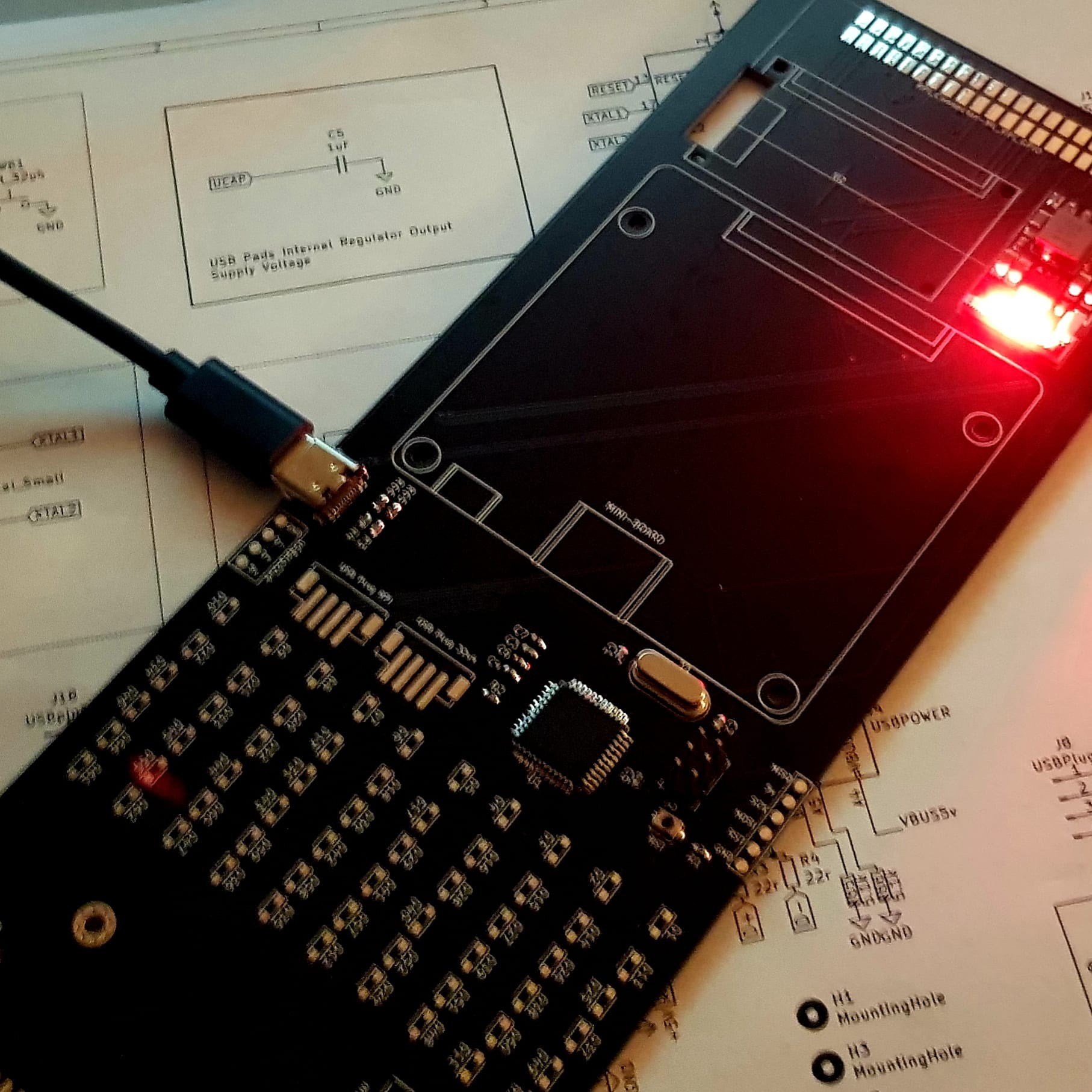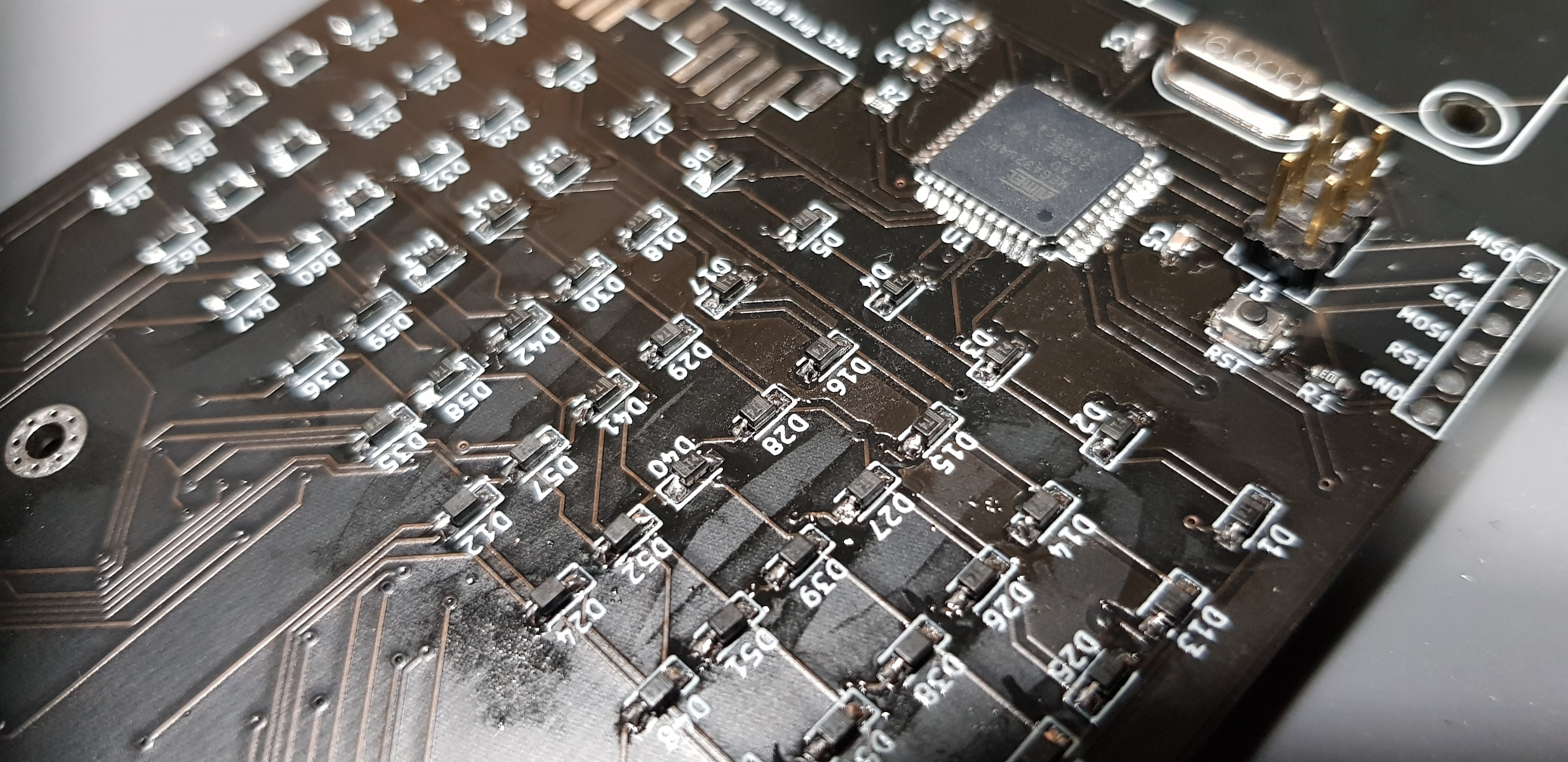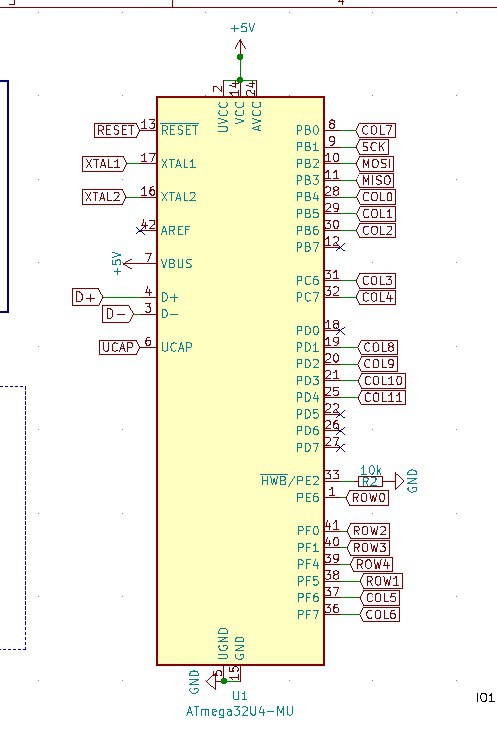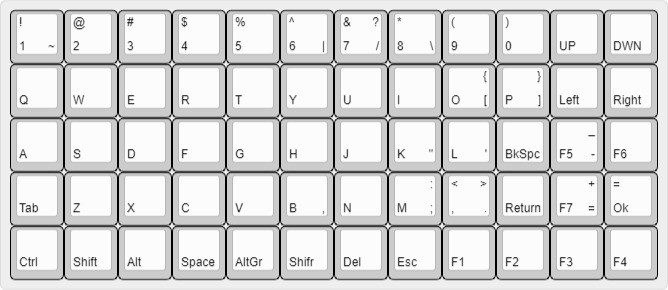yesterday we rebuit the keyboard (the old one had a circuit short which was hard to fix, due to a bad soldering technique).
We were able to flash the ATMEGA32u4 like a charm and run a sketch uploaded via ARDUINO IDE software. Good!

 Now we are preparing the QMK config files . Installation of QMK was made under linux following this Guide.
Now we are preparing the QMK config files . Installation of QMK was made under linux following this Guide. We created the new kb called BLAKRPI with ./util/new_keyboard.sh bash script and followed this guide.
Below, the schematic showing how the ATMEGA32U4 is wired


"Cyberpunk computing"'s forum post was also of great help. We were able to setup the firmware.
# MCU name
MCU = atmega32u4
# Bootloader selection
BOOTLOADER = caterina
# Build Options
# change yes to no to disable
#
BOOTMAGIC_ENABLE = lite # Enable Bootmagic Lite
MOUSEKEY_ENABLE = no # Mouse keys
EXTRAKEY_ENABLE = no # Audio control and System control
CONSOLE_ENABLE = no # Console for debug
COMMAND_ENABLE = no # Commands for debug and configuration
# Do not enable SLEEP_LED_ENABLE. it uses the same timer as BACKLIGHT_ENABLE
SLEEP_LED_ENABLE = no # Breathing sleep LED during USB suspend
# if this doesn't work, see here: https://github.com/tmk/tmk_keyboard/wiki/FAQ#nkro-doesnt-work
NKRO_ENABLE = no # USB Nkey Rollover
BACKLIGHT_ENABLE = no # Enable keyboard backlight functionality
RGBLIGHT_ENABLE = no # Enable keyboard RGB underglow
AUDIO_ENABLE = no # Audio output
rules.mk
Then we design the layout for the 60 keys
#pragma once
#include "quantum.h"
/* This is a shortcut to help you visually see your layout.
*
* The first section contains all of the arguments representing the physical
* layout of the board and position of the keys.
*
* The second converts the arguments into a two-dimensional array which
* represents the switch matrix.
*/
#define LAYOUT( \
K000, K001, K002, K003, K004, K005, K006, K007, K008, K009, K010, K011, \
K100, K101, K102, K103, K104, K105, K106, K107, K108, K109, K110, K111, \
K200, K201, K202, K203, K204, K205, K206, K207, K208, K209, K210, K211, \
K300, K301, K302, K303, K304, K305, K306, K307, K308, K309, K310, K311, \
K400, K401, K402, K403, K404, K405, K406, K407, K408, K409, K410, K411 \
) { \
{ K000, K001, K002, K003, K004, K005, K006, K007, K008, K009, K010, K011 }, \
{ K100, K101, K102, K103, K104, K105, K106, K107, K108, K109, K110, K111 }, \
{ K200, K201, K202, K203, K204, K205, K206, K207, K208, K209, K210, K211 }, \
{ K300, K301, K302, K303, K304, K305, K306, K307, K308, K309, K310, K311 }, \
{ K400, K401, K402, K403, K404, K405, K406, K407, K408, K409, K410, K411 } \
}
And defaultlayout.c
/* Copyright 2021 Dr CADIC Philippe
*
* This program is free software: you can redistribute it and/or modify
* it under the terms of the GNU General Public License as published by
* the Free Software Foundation, either version 2 of the License, or
* (at your option) any later version.
*
* This program is distributed in the hope that it will be useful,
* but WITHOUT ANY WARRANTY; without even the implied warranty of
* MERCHANTABILITY or FITNESS FOR A PARTICULAR PURPOSE. See the
* GNU General Public License for more details.
*
* You should have received a copy of the GNU General Public License
* along with this program. If not, see .
*/
#include QMK_KEYBOARD_H
// Defines names for use in layer keycodes and the keymap
enum layer_names {
_BASE,
_FN
};
// Defines the keycodes used by our macros in process_record_user
enum custom_keycodes {
QMKBEST = SAFE_RANGE,
QMKURL
};
const uint16_t PROGMEM keymaps[][MATRIX_ROWS][MATRIX_COLS] = {
/* Base */
[_BASE] = LAYOUT(\
KC_1, KC_2, KC_3, KC_4, KC_5, KC_6, KC_7, KC_8, KC_9, KC_0, KC_UP, KC_NO,\
KC_Q, KC_W, KC_E, KC_R, KC_T, KC_Y, KC_U, KC_I, KC_O, KC_P, KC_LEFT, KC_RGHT,\
KC_A, KC_S, KC_D, KC_F, KC_G, KC_H, KC_J, KC_K, KC_L, KC_BSPC, KC_F5, KC_F6,\
KC_TAB, KC_Z, KC_X, KC_C, KC_V, KC_B, KC_N, KC_M, KC_COMM, KC_ENT, KC_F7, KC_F8,\
KC_LCTL, KC_LSFT, KC_LALT, KC_SPC, MO(_FN), KC_RSFT, KC_DEL, KC_ESC, KC_F1, KC_F2, KC_F3, KC_F4\
),
[_FN] = LAYOUT(\
KC_1, KC_2, KC_3, KC_4, KC_5, KC_6, KC_7, KC_8, KC_9, KC_0, KC_UP, KC_NO,\
KC_Q, KC_W, KC_E, KC_R, KC_T, KC_Y, KC_U, KC_I, KC_O, KC_P, KC_LEFT, KC_RGHT,\
KC_A, KC_S, KC_D, KC_F, KC_G, KC_H, KC_J, KC_K, KC_L, KC_BSPC, KC_F5, KC_F6,\
KC_TAB, KC_Z, KC_X, KC_C, KC_V, KC_B, KC_N, KC_M, KC_COMM, KC_ENT, KC_F7, KC_F8,\
KC_LCTL, KC_LSFT, KC_LALT, KC_SPC, MO(_FN), KC_RSFT, KC_DEL, KC_ESC, KC_F1, KC_F2, KC_F3, KC_F4\
)
};
bool process_record_user(uint16_t keycode, keyrecord_t *record) {
switch (keycode) {
case QMKBEST:
if (record->event.pressed) {
// when keycode QMKBEST is pressed
SEND_STRING("QMK is the best thing ever!");
} else {
// when keycode QMKBEST is released
}
break;
case QMKURL:
if (record->event.pressed) {
// when keycode QMKURL is pressed
SEND_STRING("https://qmk.fm/\n");
} else {
// when keycode QMKURL is released
}
break;
}
return true;
}
 pcadic
pcadic
Discussions
Become a Hackaday.io Member
Create an account to leave a comment. Already have an account? Log In.